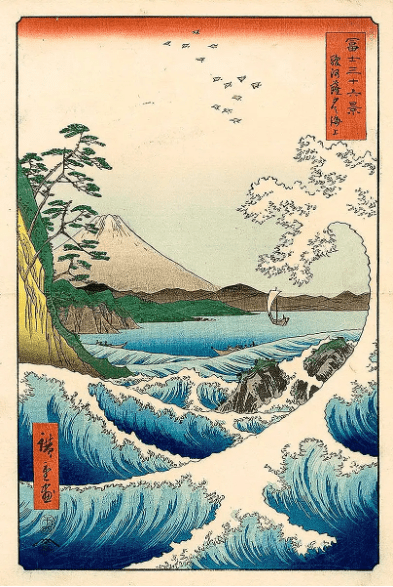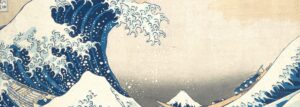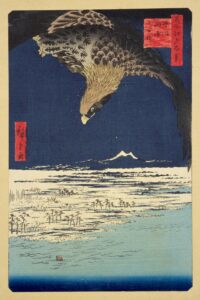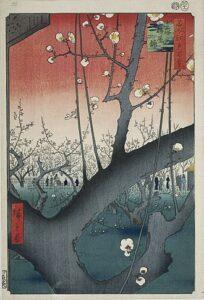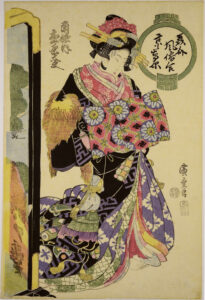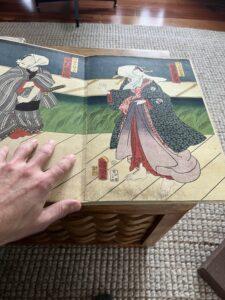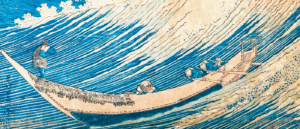Ukiyo-e, or the floating world pieces, are Japanese art genres that involve woodblock art. Unique in its form and the process of its creation, Ukiyo-e first surfaced outside Japan in the 17th century and influenced how art was created all across the globe. In fact, even the crude impressionists of the West began to incorporate Japanese woodblock techniques and their print style in their paintings and art pieces [1]. An influential outcome of the Edo period, these prints of the floating world are what the Edo period in Japan is now remembered by. The genre involved woodblock formations in 5 particular categories: beautiful women, landscapes, warriors/heroes, kabuki actors, and shunga (illegal, sexually explicit art) [2]. But safe to say, no single category trumped the other regarding the fame, beauty, and intricateness of these pieces. As a matter of fact, several collectors all over the world have been buying Japanese woodblock prints ever since they first surfaced, without a distinguished preference for a particular category [3]. So without further ado, let’s dive right into some of the most sought-after and well-liked Ukiyo-e of all time.
1: Under the Great Wave of Kanagawa by Katsushika Hokusai, 1830 [2]
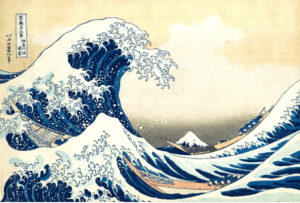
One of the best-known Japanese woodblock prints of all time, Under the Great Wave off Kanagawa comes from the 36 Views of Mt. Fuji by Hokusai. Filled with several blue shades lending into one another, three boats trapped in the wave, the painting represents how no matter the chaos, Mt. Fuji still stands. This piece has been reproduced hundreds of times over centuries. In particular, French collectors have been buying and selling several reproductions of this Japanese woodblock masterpiece over the years. The original print rests in the British Museum and is worth paying a visit to.
2: The Plum Garden at Kameido Shrine by Utagawa Hiroshige,1857 [2]
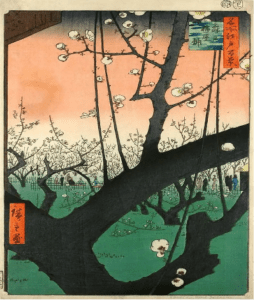 Belonging to Hiroshige’s series One Hundred Views of Famous Places in Edo, The Plum Garden at Kameido Shrine is one of the several prints that were copied by the all-time famous Dutch artist Van Gogh in oil, showing his love for Japanese woodblock prints by Hiroshige. The tree that is shown in the woodblock print is known as the Sleeping Dragon Plum and is considered a symbol of purity in Japanese color. Laced with white blossoms, the painting signifies how these plums hanging by the branches are so white they could drive the darkness out of one’s soul – just like the tree trunk.
Belonging to Hiroshige’s series One Hundred Views of Famous Places in Edo, The Plum Garden at Kameido Shrine is one of the several prints that were copied by the all-time famous Dutch artist Van Gogh in oil, showing his love for Japanese woodblock prints by Hiroshige. The tree that is shown in the woodblock print is known as the Sleeping Dragon Plum and is considered a symbol of purity in Japanese color. Laced with white blossoms, the painting signifies how these plums hanging by the branches are so white they could drive the darkness out of one’s soul – just like the tree trunk.
3: Station thirty-two: Seba by Utagawa Hiroshige, late 1830s [2]
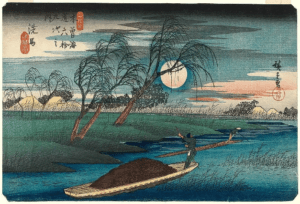 A rather color-heavy print, Station thirty-two: Seba also belonged to Utagawa Hiroshige’s One Hundred Views of Famous Places in Edo series. Hiroshige completed this art piece as a continuation of the abandoned work of Keisai Eisan of a view alongside the Kisokaido Highway. Filled with lush green lands and blooming blue waters overshadowed by the moon, the painting shows an individual at work – the Hiroshige element in this woodblock art shows people engaging in nature-oriented tasks.
A rather color-heavy print, Station thirty-two: Seba also belonged to Utagawa Hiroshige’s One Hundred Views of Famous Places in Edo series. Hiroshige completed this art piece as a continuation of the abandoned work of Keisai Eisan of a view alongside the Kisokaido Highway. Filled with lush green lands and blooming blue waters overshadowed by the moon, the painting shows an individual at work – the Hiroshige element in this woodblock art shows people engaging in nature-oriented tasks.
4: Tako to Ama, the Dream of the Fisherman’s Wife by Katsushika Hokusai, 1814 [2]
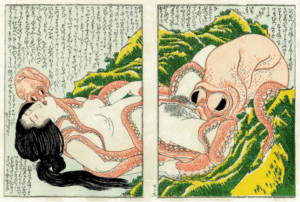 A part of the 3 volume shunga erotica book Young Pines, this Japanese woodblock masterpiece might not suit everyone’s taste. Nevertheless, one can’t go without appreciating its uniqueness. A rebellious piece of sorts, it falls under the forbidden category for Ukiyo-e art: shunga or explicit art. A remarkable piece of the Edo period, this piece depicted how Japanese woodblock artists at the time found creative ways to depict sexuality, sexual intercourse, and physical intimacy without directly breaking any laws. This print was also one of the most widely replicated ones at the time and is now found in every other household.
A part of the 3 volume shunga erotica book Young Pines, this Japanese woodblock masterpiece might not suit everyone’s taste. Nevertheless, one can’t go without appreciating its uniqueness. A rebellious piece of sorts, it falls under the forbidden category for Ukiyo-e art: shunga or explicit art. A remarkable piece of the Edo period, this piece depicted how Japanese woodblock artists at the time found creative ways to depict sexuality, sexual intercourse, and physical intimacy without directly breaking any laws. This print was also one of the most widely replicated ones at the time and is now found in every other household.
5: The Teahouse Waitress Takashima Ohisa by Katsukawa Shuncho, the 1790s [2]
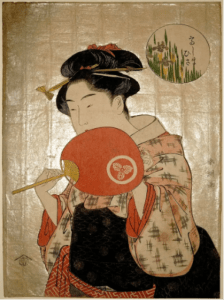 As mentioned earlier, woodblock art featuring beautiful women of Japan was a huge category in the Ukiyo-e genre, especially when this form of art began to surface. These images represent an alternate meaning to Ukiyo-e: representing the Japanese culture of Oirans and Geishas in entertainment districts where rich, wealthy Japanese men would spend the night in pure sexual and physical bliss – areas of Japan that were known as the floating world or Ukiyo-e. In this masterpiece, the woodblock artist Shuncho shows a beautiful woman dressed traditionally, her hair tied up in a traditional Japanese manner, and her holding a hand fan with three oak leaves on it. The background is largely plain, allowing the image of the woman to stand out.
As mentioned earlier, woodblock art featuring beautiful women of Japan was a huge category in the Ukiyo-e genre, especially when this form of art began to surface. These images represent an alternate meaning to Ukiyo-e: representing the Japanese culture of Oirans and Geishas in entertainment districts where rich, wealthy Japanese men would spend the night in pure sexual and physical bliss – areas of Japan that were known as the floating world or Ukiyo-e. In this masterpiece, the woodblock artist Shuncho shows a beautiful woman dressed traditionally, her hair tied up in a traditional Japanese manner, and her holding a hand fan with three oak leaves on it. The background is largely plain, allowing the image of the woman to stand out.
6: The Beloved Wife’s Particolored Reins by Toshusai Sharaku, 1794 [2]
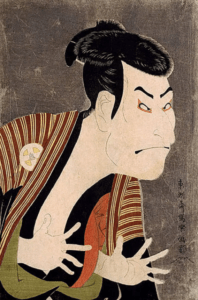
By far, the most popular category in the Ukiyo-e genre was always the one that shows kabuki artists. To put it differently, these were images that represented a complex action scene via bright contrasting colors and a captivating expression of the human figure in the images. Back in the Edo period, kabuki theatres were a critical component of Japanese culture and tradition, where there were long pauses, dramatic gestures, and metaphorical messages in the acting. To say the least, this showed how every single one of the kabuki actors was an asset to Japan on its own and deserved recognition enough to be shown in the artwork. The artist Sharaku was an avid fan of kabuki and drew woodblock art of the genre more often than any other. In the piece The Beloved Wife’s Particolored Reins, through expression imagery, and a faded background, he brings out the true nature of kabuki.
7: The Sea at Satta in Suruya Province by Uttagawa Hiroshige, 1859 [1]
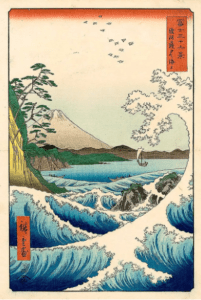 Another one from Hiroshige’s 36 Views of Mt. Fuji, this Ukiyo-e piece has traveled all the way to Boston and is currently found in The Fine Arts Museum there. One of the extremely popular landscape prints, The Sea at Satta in Suruya Province was one of the first few landscape prints that came forth after the 1830s. Prior to this, most prints were either focused on beautiful women or kabuki actors.
Another one from Hiroshige’s 36 Views of Mt. Fuji, this Ukiyo-e piece has traveled all the way to Boston and is currently found in The Fine Arts Museum there. One of the extremely popular landscape prints, The Sea at Satta in Suruya Province was one of the first few landscape prints that came forth after the 1830s. Prior to this, most prints were either focused on beautiful women or kabuki actors.
8: Evening Glow at Ryōgoku Bridge by Torii Kiyonaga, 1782 [3]
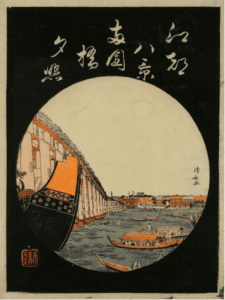
While we always talk about how impressionists of the art were influenced by Ukiyo-e, have you ever wondered if vice versa also happened? The answer is Yes! Kiyonaga’s Evening Glow at Ryōgoku Bridge is one of example. The Japanese woodblock piece has a black background and a circular image, which seems as though you’re looking at a view through a portal – a phenomenon very common in impressionist art at the time. With a unique contrast of blue and orange with the black foreground and the text above the picture written in the color of the sky, this image did a spectacular job of showing how the east also embraced western art techniques in their Japanese woodblock pieces.
9: Toki Jūrōzaemon Mitsuchika by Utagawa Kuniyoshi, 1850 [2]
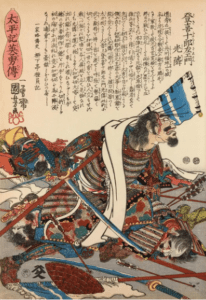 Toki Jūrōzaemon Mitsuchika is a warrior print of sorts. The image shows the famous Japanese warrior Toki Jūrōzaemon wounded and surrounded by fallen men in war. This image came forth at a time when all forms of war-related art were banned and deemed illegal in Japan. Kuniyoshi completed this artwork by changing the historical facts i.e.by changing the names and the time period, to make it seem fictional instead of a representation of one of the Japanese wars.
Toki Jūrōzaemon Mitsuchika is a warrior print of sorts. The image shows the famous Japanese warrior Toki Jūrōzaemon wounded and surrounded by fallen men in war. This image came forth at a time when all forms of war-related art were banned and deemed illegal in Japan. Kuniyoshi completed this artwork by changing the historical facts i.e.by changing the names and the time period, to make it seem fictional instead of a representation of one of the Japanese wars.
10: View of Maruyama in Nagasaki by Utagawa Hiroshige II, 1859 [1]
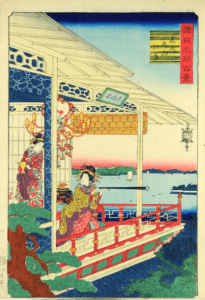 Last but not the least, there is View of Maruyama in Nagasaki, an image that is one of a kind in that it represents a part of Japan that crashed to shambles after the Nuke explosion almost 100 years after this woodblock print was made. Thus, the piece serves as a memory of an entertainment house that saw over the sea, in a city that no longer is the same.
Last but not the least, there is View of Maruyama in Nagasaki, an image that is one of a kind in that it represents a part of Japan that crashed to shambles after the Nuke explosion almost 100 years after this woodblock print was made. Thus, the piece serves as a memory of an entertainment house that saw over the sea, in a city that no longer is the same.
Are you looking to purchase woodblock print art by some of these very master Artists? Click here
to browse our current selection of Woodblock prints for sale. Currently we have Hokusai, Hiroshige, Yoshitoshi, and many more original Japanese prints for sale.
References
[1] “20 Facts You Probably Didn’t Know about Ukiyoe (浮世絵).” Tsunagu Japan, https://www.tsunagujapan.com/20-facts-you-probably-didnt-know-about-ukiyoe/.
[2] “The Ten Most Important Ukiyo-e Art Prints of All Time.” TheCollector, 21 Jan. 2022, https://www.thecollector.com/10-most-important-ukiyo-e-art-prints/.
[3] “The Ukiyo-e Artists You Need to Know – Google Arts & Culture.” Google, Google, https://artsandculture.google.com/story/the-ukiyo-e-artists-you-need-to-know/BQKC6o0k2oBRLA.

